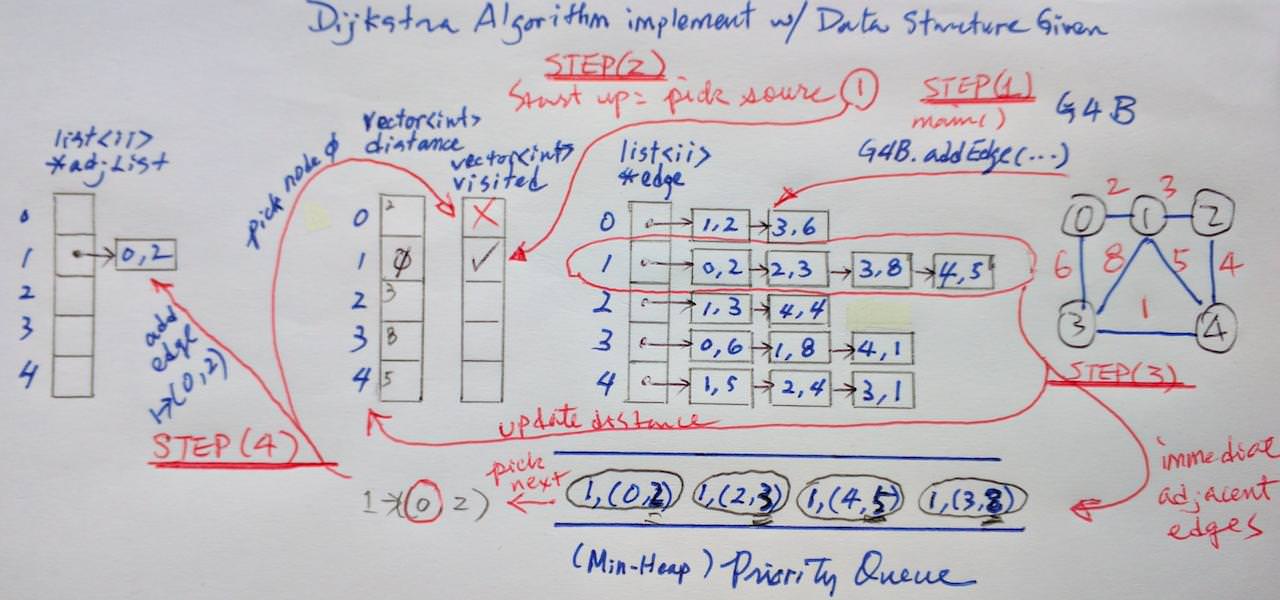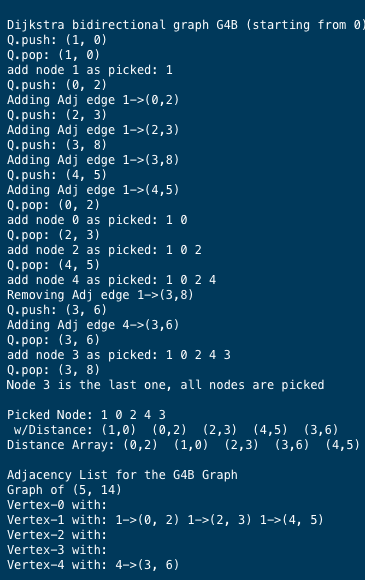Question
What needs to be implemented by you You are to modify the starter to complete the following tasks: 25 points. To implement dijkstra class method
What needs to be implemented by you
You are to modify the starter to complete the following tasks:
25 points. To implement dijkstra class method to the Graph class with built-in print utility. Your program shall print out vertex selection sequence and to show the shortest distance between the starting vertex and every vertices in the graph.
The Dijkstra C++ starter with the test driver can be found in the course github
Hint:
If you are overwhelmed by the data structures used for the Dijkstra algorithm, you are not alone. The essential technique to succeed this 210 course is to be able to use existing container as building blocks for solving a complex and/or abstract algorithm, such as the Dijkstra MST.
It has been my experience that more than half of the class run into a wall when trying to make use of multiple containers together, such as a graph (class) that we are constructing.
You may find a test_adj.cpp program on the github that demonstrating a specific implementation of a graph with 4 simple basic containers:
list
This sample file shows you to add/delete a vertex to/from a graph class implemented with the above containers.
Here is the illustration we did during the lecture on how the Dijkstra algorithm can work with the above data structures:

*The vector
Hope the technique used can ease the transition to the technique of container programming if needed.
Expected Output
Your submitted Assignment 10 dijkstra.cpp is expected to generate the following output
Inside the dijkstra class method, you are to output the following information to the console screen:
To print out vertex selection sequence
To show the MST nodes by the picked sequence pair with its distance to the starting vertex.
The output shall appears like the following:

This assignment only expected to complete the edge picking and its proper weight as shown above. The adjacency was illustrated for reference only.
If you have implemented the proper removal of unused edges for the adjacency fix, here is a sample test run on the G4B with some debug trace turned on:

Here's the program that needs to be implemented.
dijkstra.cpp
#include
#include
#include
#include
#include
#include
#define ii pair
enum GRAPH_TYPE {DI, BI};
using namespace std;
// functor overloads the compare ii
class compareII {
public:
bool operator()(const ii &j, const ii &k) {
return j.second > k.second;}
};
class Graph
{
int V, E; // No. of vertices, edges
list
list
vector
vector
priority_queue
public:
Graph(int v_num) : V(v_num), E(0) {
edge = new list
distance = vector
}
void addEdge(int u, int v, int w, int type = DI) {
edge[u].push_back(ii(v, w)); E++;
if(type != DI) {
edge[v].push_back(ii(u, w)); E++; }
}
void dijkstra(int v);
void print();
void printGraph();
void printAdjacency();
};
void Graph::printGraph() {
cout
for (auto p : pv) { cout
cout
for (auto p : pv) { cout
cout
for (int n=0; n cout cout } void Graph::printAdjacency() { cout for (int n = 0; n cout for (auto a : adjList[n]) cout (" cout } } void Graph::dijkstra(int source) { distance = vector distance[source] = 0; Q.push(ii(source, 0)); adjList = new list while (!Q.empty()) { // pop the vertex with smallest distance d of vertex v from Q // smallest d of v from Q ii top = Q.top(); Q.pop(); int v = top.first, d = top.second; // push the selected vertex v into picked vertices array pv if (d for (auto e : edge[v]) { // go through all edges e // if the distance to new node is greater than distance from current node to this node // replace the distance // push the new node and distance into the queue } } } } // Driver program to test methods of graph class int main() { // Di-graph g(5,10) Graph g(5); g.addEdge(0,1,10,DI); g.addEdge(0,4,5,DI); g.addEdge(1,2,1,DI); g.addEdge(1,4,2,DI); g.addEdge(1,3,4,DI); g.addEdge(3,0,7,DI); g.addEdge(3,2,6,DI); g.addEdge(4,1,3,DI); g.addEdge(4,2,9,DI); g.addEdge(4,3,2,DI); cout g.dijkstra(0); g.printGraph(); cout g.printAdjacency(); // Bidirection G2B (9,28) Graph G2B(9); G2B.addEdge(0,1,4,BI); G2B.addEdge(0,7,8,BI); G2B.addEdge(1,2,8,BI); G2B.addEdge(1,7,11,BI); G2B.addEdge(2,3,7,BI); G2B.addEdge(2,5,4,BI); G2B.addEdge(2,8,2,BI); G2B.addEdge(3,4,9,BI); G2B.addEdge(3,5,14,BI); G2B.addEdge(4,5,10,BI); G2B.addEdge(5,6,2,BI); G2B.addEdge(6,7,1,BI); G2B.addEdge(6,8,6,BI); G2B.addEdge(7,8,7,BI); cout G2B.dijkstra(2); G2B.printGraph(); cout G2B.printAdjacency(); Graph G3B(6); G3B.addEdge(0,1,2,BI); G3B.addEdge(0,2,3,BI); G3B.addEdge(1,2,2,BI); G3B.addEdge(1,3,6,BI); G3B.addEdge(2,3,2,BI); G3B.addEdge(2,4,3,BI); G3B.addEdge(3,4,2,BI); G3B.addEdge(3,5,6,BI); G3B.addEdge(4,5,2,BI); cout G3B.dijkstra(2); G3B.printGraph(); cout G3B.printAdjacency(); // 2 3 // (0)--(1)--(2) // | / \ | // 6| 8/ \5 |4 // | / 1 \ | // (3)-------(4) Graph G4B(5); G4B.addEdge(0,1,2,BI); G4B.addEdge(0,3,6,BI); G4B.addEdge(1,2,3,BI); G4B.addEdge(1,3,8,BI); G4B.addEdge(1,4,5,BI); G4B.addEdge(2,4,4,BI); G4B.addEdge(3,4,1,BI); cout G4B.dijkstra(1); G4B.printGraph(); cout G4B.printAdjacency(); return 0; }
Step by Step Solution
There are 3 Steps involved in it
Step: 1

Get Instant Access to Expert-Tailored Solutions
See step-by-step solutions with expert insights and AI powered tools for academic success
Step: 2

Step: 3

Ace Your Homework with AI
Get the answers you need in no time with our AI-driven, step-by-step assistance
Get Started


